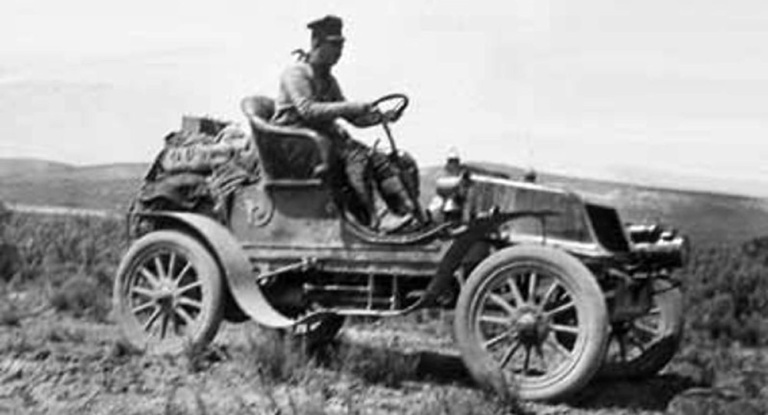
 Ken Burns Classroom
Ken Burns Classroom
 Ken Burns Classroom
Ken Burns Classroom

In the spring of 1903, on a whim and a fifty-dollar bet, Dr. Horatio Nelson Jackson set off from San Francisco in a 20-horsepower Winton touring car hoping to become the first person to cross the United States in the new-fangled “horseless carriage.” At the time there were only 150 miles of paved roads in the entire country, all of them within city limits. There were no gas stations and virtually no road maps as we know them today. Most people doubted that the automobile had much of a future. Jackson’s trip would prove them wrong.
Traveling with his co-driver Sewall K. Crocker and a bulldog named Bud (who wore goggles, just like his master, to keep the dust from his eyes), Jackson had the adventure of his life. He encountered pioneers in wagon trains, cowboys who used their lariats to tow him out of sand drifts, ranch wives who traded homecooked meals for a brief ride on the “Go-Like-Hell Machine,” and people who deliberately sent him miles out of his way just so their relatives could get their first glimpse of an automobile.
His car, which he christened the Vermont in honor of his home state, splashed through streams, got stuck in buffalo wallows, bounced over railroad trestles to cross major rivers, and frightened horses on the dusty trails. And as he moved eastward, his quest slowly became a national sensation, with huge crowds (tipped off by the telegraph of his approach) lining the streets of town as he whizzed through at 20 miles per hour. “It Startled the Natives,” one headline proclaimed; another announced “A Real Live Auto.”
This was America’s first transcontinental road trip, and like all road trips that would follow it included the usual mix of breakdowns and flat tires, inedible meals and uncomfortable beds, getting lost and enduring bad weather — and having a truly unforgettable experience crossing the nation’s vast landscape. Throughout it all, Jackson’s indomitable spirit and sheer enthusiasm was as indispensable as the fuel for his car.
Partway through his improbable journey, Jackson learned that his spur-of-the-moment trip had turned into something of a race. First the Packard company, and then the Oldsmobile company dispatched their own autos from California in the hopes of passing him and gaining the publicity of being first across the nation. Sixty-three and a half days after leaving San Francisco, Jackson arrived triumphantly into New York City and claimed the honor for himself.
On the centennial of Jackson’s achievement, Ken Burns and Florentine Films have now made a documentary film that follows his historic — and hilarious — journey. Horatio’s Drive: America’s First Road Trip is a one-episode, two-hour film that will be broadcast on PBS stations in October 2003. Burns has teamed up again with writer/producer Dayton Duncan — the same pair who brought the story of another great transcontinental adventure — Lewis and Clark’s — to vivid life on PBS. Tom Hanks is the voice of Horatio Nelson Jackson. Keith David (Jazz and Mark Twain) is the narrator.
Using a treasure trove of photographs Jackson took along the way, and relying on the previously unpublished letters he wrote to his wife from the road (read masterfully by Hanks), the film puts the viewer in the front seat of the Vermont and rides across the continent with Jackson, Crocker and Bud. Burns and Duncan retraced Jackson’s entire route to film the same scenery he saw, even mounted cinematographer Allen Moore on the hood of their car to capture the feel of fording streams and climbing rocky mountain paths.